The Best Fishing Knots Of All Time [Ranked Strongest To Weakest]
- By: Luke Simonds
- on
- Found In: Fishing Knots, Fishing Tips
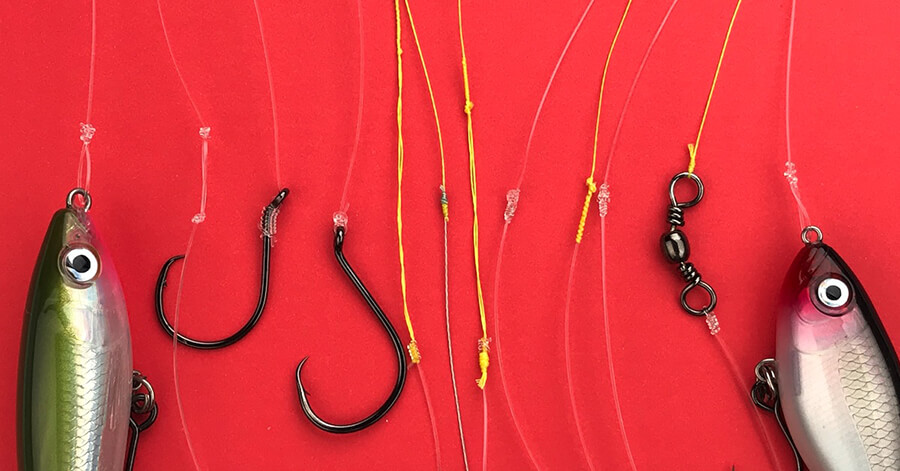
It’s fishing knot time!
Do you want to know something that might shock you about fishing knots?
After testing hundreds of fishing knots over the past couple of years, I’ve learned one very important lesson…
The “100% fishing knot” is a myth.
Why?
Physics.
Yes, simple physics is the reason why. Pretty much all knots will create a weak point on the line given that it creates a point on the line where a max load is hitting it from more than just one direction.
And although there are some instances where the main line (or leader) will break before the knot fails, there is no single knot that can always do that with all types of lines.
So step #1 in using the strongest possible knots for your fishing needs is to understand that there is no such thing as a “100% knot”…
And if you hear someone say that their knot is 100% without any exclusions, then they likely have never tested it out in a controlled test with multiple lines, so I be wary of their recommendation.
Here’s the hard truth…
Your favorite fishing knot is weak, and so is mine…
This is simply due to the fact the contorting line and creating hard turns that get put under tension will always create a weak point in the line making it the weakest point in the system (assuming that the main line is not compromised).
Note: This weak point is almost always at the first hard turn in the top section of the knot coming from the main line, so it most often leaves a clean break which looks like the mainline simply snapped when an angler examines the line after a break-off.
Now that we’re past the first hurdle (acceptance), step #2 is to actually test our knots to make sure that you don’t lose the fish of a lifetime due using a knot that isn’t the absolute best for each connection in your line system.
To help save you time in testing knots, I’ll be displaying results from my continued testing on this page.
Best of all, the individual fishing knots will be ranked based on their strength & performance results for the following knot connection categories:
The results of these knot strength tests might surprise you! 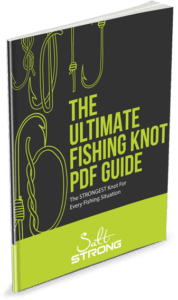 Do You Know The STRONGEST Fishing Knot For Every Situation?
Do You Know The STRONGEST Fishing Knot For Every Situation?Click here to download the FREE “Ultimate Fishing Knot PDF Guide” (only takes a few seconds)
Knot Category Groupings
Feel free to use the links below to skip down to the knot connection that you’re most interested in. Otherwise, you can simply scroll down to see all of the knots.
And if you don’t see your favorite knot listed, just leave a comment on the bottom of this post (click here) and I’ll add it to my list of fishing knots to evaluate.
So let’s get started…
Definition of Bad, Good, & Great Fishing Knots
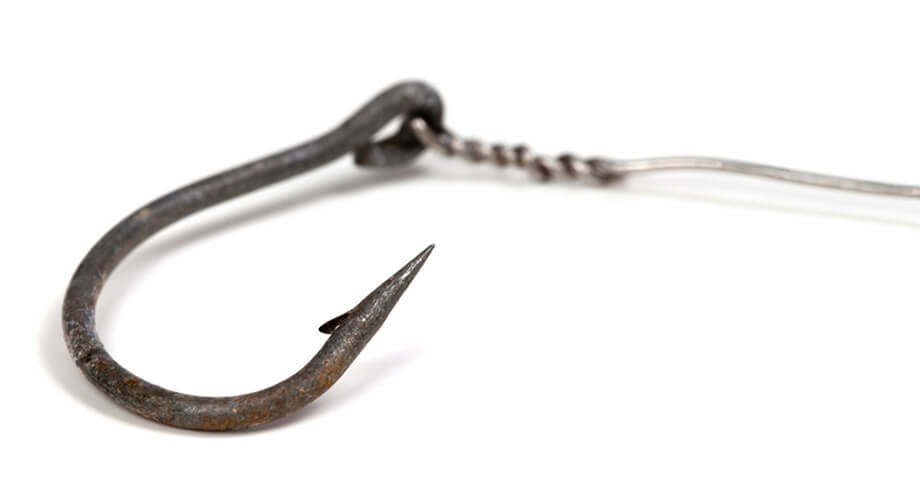
Before going on the knot strength results, it is essential that we first all understand the different categories of knots in terms of their strength:
- Bad Knot: unravels/slips when under heavy tension
- Good Knot: does not unravel or slip (it breaks before unraveling)
- Great Knot: does not unravel/slip and has a higher breaking point than “Good knots”
How To Determine A Bad Knot
A bad knot is very easy to see because it leaves behind the telltale sign of trouble… the curly tag end.
Yes, the curly tag end that you may have seen after a break-off means that the knot used was either a bad knot, or there was a poor job in tying a good/great knot.
So if you ever see the curly end after a break-off, do not tie the same knot the same way because it’ll likely happen again.
How To Determine A Good Knot vs. A Great Knot
The difference between a Good knot and a Great knot requires the act of intentionally breaking them under a controlled test to see how much tension they can hold before the break occurs.
This is the missing link that most anglers overlook because it requires time and effort.
I am the perfect example of this because I was even fishing tournaments with money and pride at stake and never even bothered to actually test my personal knots.
And when I finally did test my knots, I was shocked at the results… the very first test I did revealed that I was getting 30% less strength than I otherwise would have had I been simply using a different knot for my line to leader connection (replacing the Double-Uni knot with the FG knot… both shown below).
So I highly recommend testing out your knots. And if you’d like a shortcut, this page shows the results from my testing below to help guide you to the best knots from my many tests done so far.
And I’ll continually update this “best fishing knot” post as more and more knots are tested so that you can have the latest and greatest data.
So if you want to save time while maximizing your line strength, this post is for you.
What Are The Best Fishing Knots?
There are many different types of lines which in many cases have completely different textures, sizes, and friction coefficients.
So we’ll be evaluating knots based on the type of line used within these general line categories:
- Braid
- Monofilament/Fluorocarbon
- Wire (Coming soon)
- Flyline (Coming soon)
And to truly evaluate a fishing knot, it is essential to focus each test on a specific type of connection because a knot that is very good for line-to-line connections is often not good at all for line-to-lure connections (and visa-Aversa).
So we’ll break out the rankings shown below into the following connections types for each line category:
- Line-to-Line Knots
- Line-to-Hook/Lure Knots [Snug]
- Line-to-Hook/Lure Knots [Loop]
The results of these knot strength tests might surprise you!  Do You Know The STRONGEST Fishing Knot For Every Situation?
Do You Know The STRONGEST Fishing Knot For Every Situation?Click here to download the FREE “Ultimate Fishing Knot PDF Guide” (only takes a few seconds)
Best Fishing Knots for Braided Line
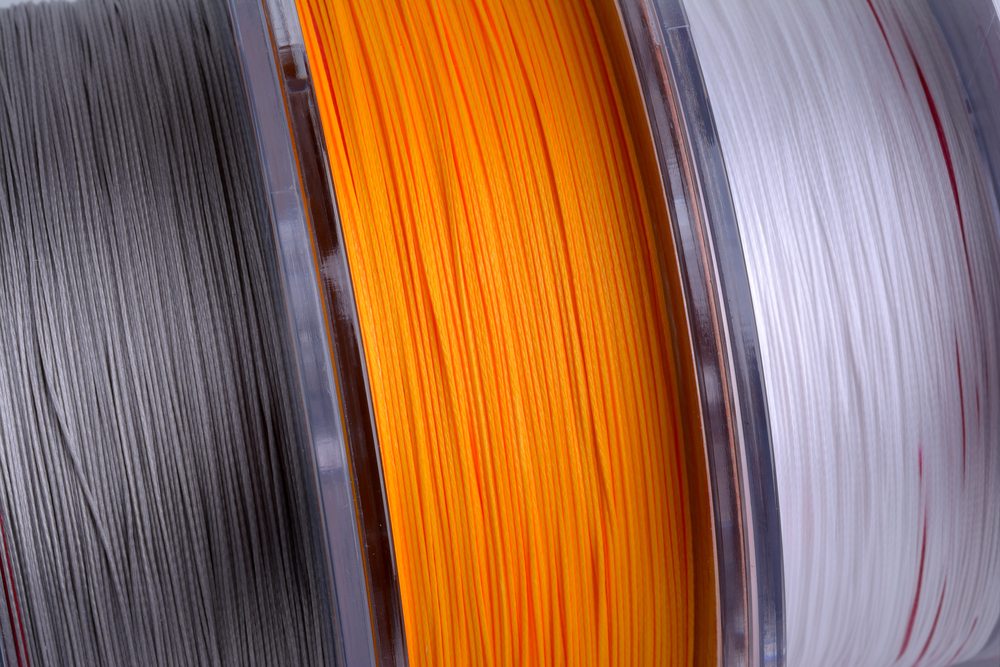
Braided line has quickly become an extremely popular choice for inshore anglers because it allows for longer casts and better feel of lures given that its strength to diameter ratio is so much higher than mono/fluoro lines.
Plus, it has very little stretch which enables the angler to feel even the lightest of taps on the other end of the line.
But braid requires much for friction within the knot compared to monofilament so it almost always requires a different knot than the traditional knots used on mono.
Best Braid to Leader Knots
To kick things off, we’ll start with the most important of all connections for most saltwater anglers who use a lighter main line to connect to a stronger leader.
This setup is becoming very common because it allows for the overall system to have optimal casting performance (due to the lighter line in the reel) while having a stronger leader line at the business end to hold up to the sharp teeth and/or rough mouths of the target species.
Fluorocarbon is the most commonly used monofilament leader these days since it’s known for being less visible in the water while also being more resistant to abrasions, so this analysis is focused on connecting a braided line to a fluorocarbon leader.
Here are the top 5 ranking knots based on the knot tests I’ve done so far:
- PR Bobbin Knot [requires tools]
- Pro: This is an extremely strong knot when tied correctly
- Con: Requires tools to tie and takes a long time (extremely tough to do while on the water)
- FG Knot*
- Pro: Thinnest knot I’ve ever seen while also having the highest breaking strength.
- Con: Requires a strong cinch before cutting the tags so that it fully locks into place.
- Note: Only use this knot if tying a braided line to a stronger mono/fluoro leader.
- 6 Turn Surgeon’s Knot
- Pro: Very quick to tie while having a shocking strong breaking point and can be tied using lines of any size
- Con: Bulkier and slightly weaker than the FG knot
- Doubled-Over Double Uni Knot
- Pro: Easy knot to tie and it can be used for all connections
- Con: Up to 30% weaker than the FG knot in my tests
- Crazy Alberto Knot
- Pro: Nice low profile knot with a strong breaking point
- Con: Up to 30% weaker than the FG knot in my tests
- Improved Albright
- Pro: Nice low profile knot with a strong breaking point
- Con: Weaker than the FG knot and the Crazy Alberto
- GT Knot
- Pro: The viral version is easy to tie
- Con: This knot isn’t nearly as strong as it’s touted for lighter lines
Click here to see the first contest I hosted for this connection.
Note: If your favorite knot isn’t included, leave a comment below and I’ll test it out and add it to the list.
Best Doubled Braid-to-Leader Knots
Many anglers like to double the braid by forming a loop at the end of the braid and then tying a line-to-line knot to connect the doubled braid to the leader.
In many instances, this does increase the overall line strength for anglers who are using a lighter braid relative to the leader.
However, the FG knot tied on a single line has proven to outperform the doubled knot connections in most of my testing. The only combination that consistently beats the single line FG knot is the use of the FG knot to connect a doubled line formed by the Bimini Twist to the leader.
Line Doubling Knots [Braid]
- Bimini Twist
- Pro: Extremely strong doubling knot
- Con: It often requires more twists (30+) with braid so that it won’t slip
- Spider Hitch
- Pro: Faster to tie than the Bimini Twist
- Con: Not as strong as the Bimini Twist
- Surgeon Loop (6-turn)
- Pro: Extremely fast to tie
- Con: Not quite as strong as the Bimini Twist
Doubled Line To Leader Knots [Braid to Fluoro]
- FG Knot
- Pro: Thinnest knot I’ve ever seen while also having the highest breaking strength.
- Con: Requires a very strong cinch before cutting the tags so that it fully locks into place.
- Note: Only use this knot if tying a braided line to a stronger mono/fluoro leader.
- No-Name Knot (aka- Bristol Knot)
- Pro: Quick and easy knot to tie
- Con: Not as strong as the FG knot
- Yucatan Knot
- Pro: Quick and easy to tie (very similar to Bristol knot)
- Con: Not as strong as the FG knot
Note: If your favorite knot isn’t included, leave a comment below and I’ll test it out and add it to the list.
Best Braid-to-Swivel/Lure/Hook Knots
This next category is focused for anglers who use braided line and like to use swivels.
But it could also be useful if you like to use connect your braided line directly to your terminal tackle (although I do not recommend tying directly to your lure or hook using braid because fish can see it so much better than mono/fluoro… instead, use a ~20 to 30 inch leader in between your braid and lure/hook).
- Braid Uni Knot
- Pro: Great knot that is very strong and easy to tie
- Con: Although an easy knot to tie, some are faster
- San Diego Jam Knot
- Pro: Strong knot that is easy and quick to tie
- Con: Not quite as strong as the Modified Uni Knot
- Palomar Knot
- Pro: Very fast and easy to tie
- Con: Not as strong with braid as it is with mono
- Orvis Knot
- Pro: Quick and easy to tie
- Con: Not as strong with braid as it is with mono
- Improved Cinch Knot
- Pro: Quick and easy to tie
- Con: This knot doesn’t perform well with braid (prone to slippage)
- Clinch Knot
- Pro: Quick and easy to tie
- Con: This knot doesn’t perform well with braid (prone to slippage)
Click here to see results from a contest I hosted for this connection.
Note: If your favorite knot isn’t included, leave a comment below and I’ll test it out and add it to the list.
Best Fishing Knots for Monofilament/Fluorocarbon Line
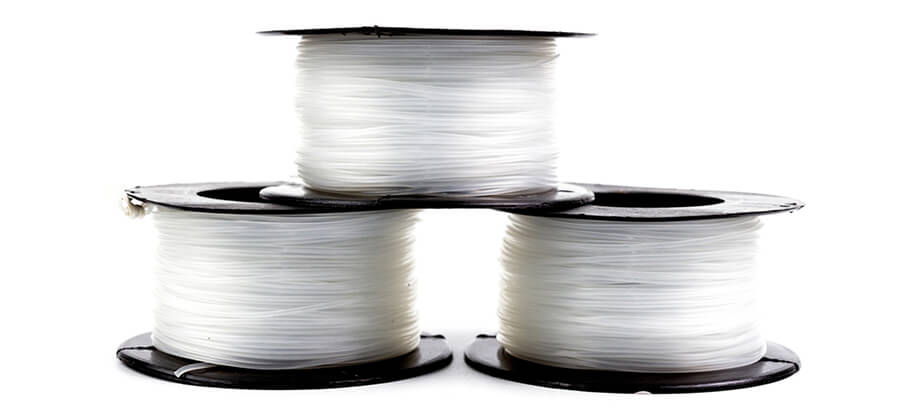
Monofilament line is used by almost all anglers in some capacity, so I’ve done many tests with knots using mono line.
For tests that I’ve done for my personal use, I focused on Fluorocarbon line, which is a specific type of mono.
Many anglers use Fluorocarbon for their leader material since it’s known to be stronger the less visible than traditional monofilament line.
Here’s what I’ve tested so far:
Best Mono-to-Mono Knots
Here are the top mono-to-mono knots that I have tested:
- Blood Knot*
- Pro: Easy to tie with lines of similar size
- Con: Not as effective with lines of different diameters
- Double Uni Knot
- Pro: Easy knot to tie and it can be used for all connections
- Con: Not as fast or strong as the Surgeon’s knot
- 3 Turn Surgeon’s Knot
- Pro: Extremely easy and fast knot to tie with very strong holding strength
- Con: Need to tie this before tying on a lure or hook
- SS Knot
- Pro: Versatile knot connection with an impressive breaking strength
- Con: Not quite as fast or strong as the Surgeon’s knot
- Albright Special
- Pro: Easy knot to tie that looks very nice once completed
- Con: Not as fast or strong as the Surgeon’s knot
Click here to see results from a contest I hosted for this connection.
Note: If your favorite knot isn’t included, leave a comment below and I’ll test it out and add it to the list.
Best Line-to-Hook Knots [Mono/Fluoro]
Now that we covered the very important line-to-line connection, let’s dig in to the best fishing knots for connecting our hooks and lures to the end of the line.
For this category, we’ll split it up into two sections to cover the two core different types of connections:
- Loop Knot – Leaves a loop so that the lure/hook has more range of motion in the water (less strength compared to snug)
- Snug Knot – Line hugs around hook/lure eye forming a strong connection (less range of motion)
Note: I’ve specifically focused on fluorocarbon line since it’s the most popular for saltwater anglers… if you want me to test these with standard mono, just let me know and I’ll add it to this post.
Best Loop Knot to Lure/Hook
When fishing with artificial lures, using a loop knot is an advantage because it allows the lure to have more motion in the water which most often leads to more strikes.
But the downside is that loop knots are not as strong as snug knots, so that needs to be taken into account when selecting your leader line size and when setting drag.
Here are my favorites:
- Rapala Loop Knot
- Pro: The strongest loop knot I’ve tested so far
- Con: Takes a bit longer to tie than many others and leaves a tag end facing up which can snag weeds/debris
- Non-Slip Loop Knot (aka. Kreh Loop)*
- Pro: Very quick and easy to tie and has a tag end that points down towards the lure (more weedless)
- Con: Just a tad weaker than the Rapala knot
- Figure 8 Loop Knot
- Pro: Tested to be very strong (very close to Rapala Loop Knot
- Con: Takes longer to tie than the Non-Slip Loop knot and does not have a weedless tag end
- Perfection Loop Knot
- Pro: Strong loop knot that is quick to tie
- Con: Tougher to tie since this knot requires the hook/lure to pass through a loop
- Canoe Man Loop Knot
- Pro: Extremely fast loop knot to tie
- Con: Strength test was great with traditional mono, but it didn’t perform nearly as well with fluorocarbon
Click here to see the first contest I did with this important connection.
Note: If your favorite knot isn’t included, leave a comment below and I’ll test it out and add it to the list.
Best “Snug” Knot to Lure/Hook
When going for maximum strength when having action in the water is not as important, then the snug knot is the way to go because a good snug knot will be a significant amount stronger than a good loop knot.
Here’s my ranking of the Snug knots that I’ve tested so far:
- Palomar Knot
- Pro: Very strong knot that is easy to tie when using bare hooks
- Con: Can become cumbersome when using larger lures because it requires the lure pass through a loop
- Clinch Knot
- Pro: Quick and easy knot to tie
- Con: Not as fast and easy as the Orvis Knot nor as strong as the Palomar Knot
- Uni Knot
- Pro: Good knot that is fairly quick to tie and can be used for almost any connection
- Con: Not quite as strong as the Palomar knot nor the Clinch knot
- Orvis Knot*
- Pro: Very quick and easy knot to tie that is very strong
- Con: Not quite as strong as the knots listed above
- Double Davy Knot
- Pro: Very quick and easy to tie (just 1 more twist vs. the Davie Knot)
- Con: Not quite as strong as the Orvis knot which is just as easy to tie
- Davy Knot
- Pro: Very quick and easy to tie
- Con: Not quite as strong as the Orvis knot which is just as easy to tie
Click here to see the first contest I did with this important connection.
Note: If your favorite knot isn’t included, leave a comment below and I’ll test it out and add it to the list.
More test data getting added soon, so be sure to bookmark this page!
Conclusion
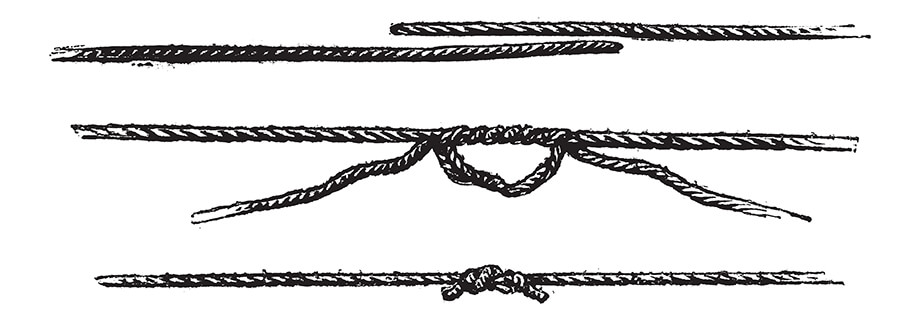
Of the many factors that determine if you land the fish of a lifetime that you hook, the one that we have 100% control over is the quality of the knots that we use.
So it’s essential for us to select the absolute best fishing knot for each connection to get the most overall line strength.
You have certainly heard the saying, “A chain is only as strong as its weakest link…” Well, a rod, reel, and an angler are only as strong as the knot between them and the fish.
Make it count.
There isn’t (and never will be) one fishing knot that can do everything with all line types and connection needs, so make sure to be mindful of the knot options you have for each connection need you have.
This post will continually grow over time as knot suggestions come in, so leave a comment below letting us know of any other knots you’d like us to add to this analysis.
Note: The * symbols next to the knots listed above are the ones that I personally use for each of the respective connections.
The tests have been done using 10 to 20 lb PowerPro braid tied to 20 to 30 lb Ande monofilament and Seaguar fluorocarbon.
The results of these knot strength tests might surprise you!  Do You Know The STRONGEST Fishing Knot For Every Situation?
Do You Know The STRONGEST Fishing Knot For Every Situation?Click here to download the FREE “Ultimate Fishing Knot PDF Guide” (only takes a few seconds)
Related Posts:
1. How To Tie The Perfect Leader Assembly For Inshore Fishing
2. What Is The Proper Drag Tension To Use For A Fishing Reel?
3. How To Get A Hooked Fish Out Of Structure Without Breaking Off
4. The Best Online Fishing Club…
P.S. – If you think your angler friends or fishing networks would enjoy seeing this, please Tag them or Share this with them. You Rock! Pa-POW!
Related categories:
STOP WASTING TIME ON THE WATER!
Do what the “SMART ANGLERS” are doing and join the Insider Club.
Here’s what you’ll receive today when you join:
- Weekly fishing reports and TRENDS revealing exactly where you should fish every trip
- Weekly “spot dissection” videos that walk you through all the best spots in your area
- Exclusive fishing tips from the PROS you can’t find anywhere else
- Everything you need to start catching fish more consistently (regardless if you fish out of a boat, kayak, or land).









Where is the PDF download??
Here’s a link to get the knots PDF: https://secure.saltstrong.com/fishing-knot-pdf-guide
Field and Stream did a comprehensive test a few years back using some sort of mechanized device, and determined the five turn improved clinch was the strongest mono-to-eye knot.
Then they must not have included the trilene knot nor the fish n fool knots if they found the improved clinch to be the strongest.
One “knot” not mentioned is spliced hollow core braid. I’ve tested it, and the mainline break not the splice.
What’s the thinnest braid that you’ve spliced?
Any information on the “ no name knot” or “ fishing fool knot”?
Thanks.
Op
Both are solid knots. The Fishing Fool Knot is essentially a Uni knot that has the line go through the hook eye twice instead of once, and that gives it a slight strength advantage.
The No Name knot is also called the Bristol knot, and that’s used for connecting a braid mainline to a mono/fluoro leader… it’s a solid knot, but not as strong/thin as the FG knot.
Thanks Luke.
How about adding the original version of the GT knot? The viral version isn’t as strong as claimed, but the original version is stronger than the Yucatán or Improved Bristol, and perhaps even stronger than the FG Knot. There’s a video of the original GT knot on the Toit website, although strength tests are still pending…..
I did try it out, and I was not able to get it to even work at all with the lighter lines that I use (10 lb braid to 30 lb leader). So it’s either I am not capable of tying that knot or there’s a reason why it wasn’t entered into the light line division of the contest… I can’t say for certain which is true.
Well, I tested the original GT knot with 30 lb braid and 25 lb leader, and it didn’t work for me either after multiple attempts. I think the braid has to be at least 50 lbs for it to work as advertised.
Thanks for the reply!
As for snug mono leader-to-lure knots, there are at least 3 knots I’ve found that will do better than the Fish N Fool knot: The Toit knot with 3 passes through the lure eye vs two; the Miller knot with 3 passes through the lure eye; and Jack’s knot 3.0. Would be interesting to see if you can get the same results or not….
I should have prefaced the above comments with the note that, according to the Knot Wars website, the Fish N Fool knot sits at the top of their list of strongest mono snug knots which includes the Palomar, the knot that currently sits at the top of your list. But the three knots I listed above (Triple Toit, Triple Miller and Jack’s 3.0) outdid even the Fish N Fool knot by a fairly good margin in my own bench tests.
Thanks for sharing your results. I tried some knots like the Uni and Trilene with 3 turns through the eye, and they at some instances did better than 2 times, but they sometimes would break lower to the point where the avg was slighter better for 2 than 3… that very well could have just been an error on my part when cinching them down.
My overall favorite for strength is the Trilene knot with a slight change in that I don’t thread the line through the wraps that go around the eye (that takes away the surface area touch points of the line and the eye which seems to do more harm than good).
Overall, I haven’t done nearly as much testing with snug knots because I rarely use them… and when I do, I’m using them only on my leader line which is much stronger than my main line so I have no reason to worry about selecting the strongest one… I typically just go with an orvis knot since it’s super quick and easy to tie while it’s still much stronger than my line to line knot.
I appreciate your response!
With 3 passes through the lure or hook eye, you need to make sure the wraps are parallel and not crossing each other. Otherwise the overlapping line will cut the line underneath it. If your hook eye is small, it’s harder to avoid crossing wraps, but lure eyes tend to be roomy enough that the 3 wraps don’t bunch and cross.
I like how you modified the Trilene knot by passing the line through the Y instead of the 2 loops around the hook eye. I’m going to try doing that for the Toit and Miller knots to see if that makes for a better knot than the standard ties. I’ll let you know.
BTW, the reason I use a leader that’s lighter than my braid main line is that, if the line breaks at all, I want the line to break at the lure or hook rather than at the connection between braid and leader, or at the loop knot somewhere even further up the main line. That facilitates rapid re-tying with only one knot vs two or three to get back in business. You don’t want to be messing with multiple difficult knots in the middle of a hot salmon bite, since the window for hot bites is often frustratingly narrow.
FYI, here in the Pacific North West (or Pacific North Wet, as we like to call it!), we’re fishing open water when we’re fishing for king or coho salmon, so we can get away with lighter leader than you can when fishing the flats, reefs or mangrove lined channels in Florida and the Southeast Coast. And salmon teeth are such that the light leader can slide easily between the needle sharp teeth without being cut, and thus bite-offs are a rare event. If we happen to hook a dogtooth shark, now, that’s another story….
As promised, I tested the Triple Toit and Triple Miller standard ties head-to-head against versions based on your improvement to the Trilene knot — going through the Y instead of through the loops at the hook eye.
In both cases, the modifed knots outperformed the standard ties five times out of five.
Then I tested the two improved knots against each other, and the improved Miller knot bested the improved Triple Toit five times out of five. I think the modification favored the Miller knot more than the Toit, as in prior tests those two knots were almost even, with the Toit winning 3 out of 5 contests.
So I have a new favorite terminal knot, thanks to you!
I’m glad to see that my experimental version of the Y vs. the loops showed some upside in your testing too!
My next suggestion was to put the Toit knot against the Trilene with an equal amount of twists… for example, if the Toit knot has 5 twists up the line, and then 5 more twists up the doubled line, then give the Trilene 10 total twists. My hunch is that the Trilene would win since it’s spreading the load more evenly. Note: I would suggest using 2 turns around the hook eye to help make sure they the coils can cinch down properly.
I’ve done as you suggested, tying the Toit with 3 turns up and 3 turns down, and the Trilene with 6 turns — with the tag ends going through the Y’s instead of the loops around the hook eyes in both knots.
The Toit won 5 head-to-head contests out of 5. While the Trilene is admittedly a pretty good knot, the.Triple Toit is even better, and the Triple Miller knot is even stronger than the Toit in my bench tests.
Thanks for sharing the findings! What line(s) are you using for the tests? Are you measuring the breaking points… if yes, how did they do?
FYI I tested the knots with 15 lb test first; then I decided to try it with 25 lb test. The results were essentially the same, with the Toit winning in 4 of the contests and tying in the 5th (the line breaking halfway between the two hooks).
However, when I tested the Triple Toit knot against the Triple Miller, the Toit came out on top with 15 lb test while the Miller knot won out with the 25 lb test. I wasn’t expecting that result. So now I’ll use the Triple Toit with the lighter leader (15 and below) and the Triple Miller with the heavier leader (25 and above). I had previously tested the two knots using 20 lb test, and at that line weight they were pretty much even.
I hope you enjoyed learning a bit along with me!
In these tests I used P-Line FluoroClear in 15# and 25# test, and P-Line CX Premium in 20# test. These are fluorocarbon coated copolymer lines engineered for low stretch, thin diameter, low visibility and decent abrasion resistance. These are the lines I tend to use most often for casting or jigging for chinook and coho salmon in the salt (I’lI go lighter for salmon and steelhead in the rivers, usually 12# and sometimes 8#). I tested the knots head-to-head against each other, 5 tries per contest, using matching 7/0 straight shank large-eye saltwater rated Siwash hooks. I stretched the line by hand using slow steady pulls vs hard snaps, with the hooks held in the thumb/holes of a couple pairs of scissors while I held the open scissors by the other scissor handles. I didn’t try measuring the breaking points as I don’t have the proper equipment for that. I just wanted to know which of the top-rated knots held up the best using the lines I use the most….
PS The lines were brand-new.
I’m looking for a braid to braid knot
Here’s the knot that I trust the most for connecting 2 braids: https://www.saltstrong.com/articles/modified-uni-knot-for-braid/
Looking for the best way to tie braided line to a spinning reel. Thanks and tight lines
I recommend against doing that because braid can end up slipping around the spool’s arbor which would essentially make it useless. The safest and most affordable way to load a spool is to start with mono to secure to the arbor (and load the bottom of the spool with cheaper line), and then add braid for the top ~150 to 200 yards.
Interested in best knot for lead core line to mono, the mono would be fluorocarbon and weaker than the lead core. The Wilis knot seems to be popular and is easy to tie.
any recommendation on wire to mono knots?
Here’s the best wire to mono knot that we’ve found so far: https://www.saltstrong.com/articles/best-wire-to-leader-knot/
Thank you for doing such extensive research and posting the results for the others of us too lazy to do the work!!
My situation in freshwater is almost 180 degrees from use in salt water. I use 50-60 lb. braid main line tied to 12-20 lb. fluorocarbon leaders. The knot tying is obviously done with a thicker main line to a smaller diameter leader.
Have you ever tested the strongest knots for lines of vastly different diameters, and not similar diameters? It’s not just a matter of doubling the braid when using braid/fluorocarbon with greatly different diameters……..as some say?
Once again, thank you for your testing results!